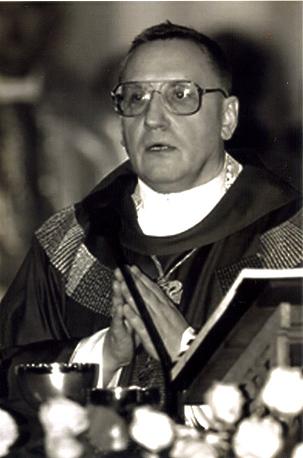Belarus was since the beginnings of the 18th century part of the Russian Empire, but was Polish and therefore catholic influenced within it’s elite. Up to the revolution of 1905, the tsars suppressed every kind of national or cultural autonomy massively. The freedom of the Roman as well as the Greek-Catholic Church were restricted; especially the uniated faithfull had to suffer since they were forbidden in 1839. Only the eparchy of Chelm existed up to 1875, when it was suppressed by the tsarist regime. Most of the uniated faithfull changed to Latin rite, while the ones who were forced to convert to orthodoxy were only allowed after 1905 to return to Latin, but not to Greek catholic rite.
This suppression went over to the atheistic dictatorship, which begun in 1918 with the proclamation of the Belarus Socialist Soviet Republic. Since 1922 part of the USSR, between 1941 and 1943 the country was occupated by the German army. After decades of brutal repression Belarus became independent in 1991 without, in fact, respecting civil rights indeed.
The Roman Catholic Church was structured genuinely in the 1783 established metropolitan see of Mohilev and the diocese of Minsk, which was erected the same year. In spite of this nomenclature, the archbishop of Mohilev in fact resided not in Belarus but in Sankt-Peterburg respectively Petro-/Leningrad. Under the tsars, an own catholic hierarchy was forbidden in Russia due to demands of the Russian orthodoxy and claims of nationalistic policy. Therefore the catholic hierarch used a title from outside orthodox territories. Only in 1991, when John Paul II united both sees to the new Metropolitan see of Minsk-Mohilev and erected the dioceses of Grodno (1991) and Vitebsk (1999), Belarus got it’s own hierarchy. Only Minsk and the 1925 established diocese of Pinsk had their own bishops up to 1925 respectively 1946.
On April 13, 1991, the pope elected the already 76 years old Monsignor Kazimierz Świątek, who served as vicar general of Pinsk since 1989, as first archbishop of Minsk-Mohilev. In the consistory of November 26, 1994, he was raised as Belarus‘ first cardinal. He stayed, highly honoured and respected, in office up to June 14, 2006. Cardinal Świątek is a symbol of his country’s poor catholic history: In 1944, after the retreat of the German occupation, he immediately was arrested by the Soviet regime and condemned to ten years of prison. After some months of imprisonment in Minsk he had to stay for two years at a Siberian gulag, before he was transferred to a labour camp in Workuta. Only in 1954 Świątek was freed and returned for his pastoral work to Pinsk.
The Roman Catholic Belarussians in exile were cared for by Apostolic Visitators:
13.06.1952 – 02.07.1960: Bolesļavs Sloskāns, Titular Bishop of Cillio
02.07.1960 – 04.10.1981: Cheslav Sipovich, M. I. C., Titular Bishop of Mariamme
01.07.1983 – 02.01.1986: Vladimir Tarasevitch, O. S. B., Titular Bishop of Mariamme.
From 1986 up to his death in 2015 Fr. Alyaksandr Nadsan (August 8, 1926 – April 15, 2015) served as Apostolic Visitator with residence in London.


The united church in today’s Belarus was forbidden in 1839. In 1798 the Ruthenian diocese of Minsk was established, but in fact suppressed only a short time after. Up to 1914, it officially was administered by a Latin bishop, before it was dissolved in 1925. On January 16, 1931, the now blessed bishop Mykola Charnetskyi, C. SS. R., was appointed as visitator for Greek catholic faithfull in Volhynia, Cholmshchyna, Podlyssia and Pidlyashshia, that is the Northern Ukraine and Southern Belarus. In 1939, Ukrainian Metropolitan Sheptyckyj of Lviv established without consense of the Holy See an Archiepiscopal Exarchate of Belarus, which was acknowledged by Rome in 1941. Due to the war it was abolished as soon as 1944. From 1939 up to 1940 bishop Mykola Charnetskyi, C. SS. R., was Locum Tenens of this Exarchate, while from 1940 up to 1943 Fr. Antoniy Nemantsevich, S. I., was first and only Exarch. He was arrested by the Gestapo in 1942 and died on January 6, 1943, in prison. Clandestine parishes did, especially after communists‘ return, not exist any longer, and only in 1990 re-establishment started in Minsk, Polotsk and elsewhere.
In 1994, the Polish Archimandrite Sergey (Jan Sergiusz) Gajek, M. I. C., was appointed first new Apostolic Visitator for uniated faithfull in Belarus. These are living in one deanery with then eleven and today (2023) sixteen parishes. In spite of this, the situation remains difficult, for the state recognizes only the Russian orthodox and Roman Catholic, but not the Greek Catholic Church. This one is only tolerated without being allowed to build churches; a Ukraine descending monk was deported. The parishes themselves were recognized by the Holy See without being bound together by a canonical ecclesiastical territory, obviousely due to orthodox wishes. The visitator, living in Rome and Lublin, only comes to Belarus for visitation purposes. In 2023 an Apostolic Administration was erected with Archimandrite Gajek heading it.
The author sincerely thanks Fr. Manuil Pyshkovych, M. S. U., Univ, for his assistance on this complex topic. The photos are from the author’s archive.
SEE ALSO:
ZURÜCK/BACK